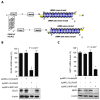Covalent Strategies for Targeting Messenger and Non-Coding RNAs: An Updated Review on siRNA, miRNA and antimiR Conjugates
- PMID: 29415514
- PMCID: PMC5852570
- DOI: 10.3390/genes9020074
Covalent Strategies for Targeting Messenger and Non-Coding RNAs: An Updated Review on siRNA, miRNA and antimiR Conjugates
Abstract
Oligonucleotide-based therapy has become an alternative to classical approaches in the search of novel therapeutics involving gene-related diseases. Several mechanisms have been described in which demonstrate the pivotal role of oligonucleotide for modulating gene expression. Antisense oligonucleotides (ASOs) and more recently siRNAs and miRNAs have made important contributions either in reducing aberrant protein levels by sequence-specific targeting messenger RNAs (mRNAs) or restoring the anomalous levels of non-coding RNAs (ncRNAs) that are involved in a good number of diseases including cancer. In addition to formulation approaches which have contributed to accelerate the presence of ASOs, siRNAs and miRNAs in clinical trials; the covalent linkage between non-viral vectors and nucleic acids has also added value and opened new perspectives to the development of promising nucleic acid-based therapeutics. This review article is mainly focused on the strategies carried out for covalently modifying siRNA and miRNA molecules. Examples involving cell-penetrating peptides (CPPs), carbohydrates, polymers, lipids and aptamers are discussed for the synthesis of siRNA conjugates whereas in the case of miRNA-based drugs, this review article makes special emphasis in using antagomiRs, locked nucleic acids (LNAs), peptide nucleic acids (PNAs) as well as nanoparticles. The biomedical applications of siRNA and miRNA conjugates are also discussed.
Keywords: RNA interference; covalent approach; gene delivery; gene therapy; miRNA technology; non-coding RNA; nucleic acid conjugates.
Conflict of interest statement
The authors declare no conflict of interest.
Figures









References
Publication types
LinkOut - more resources
Full Text Sources
Other Literature Sources

